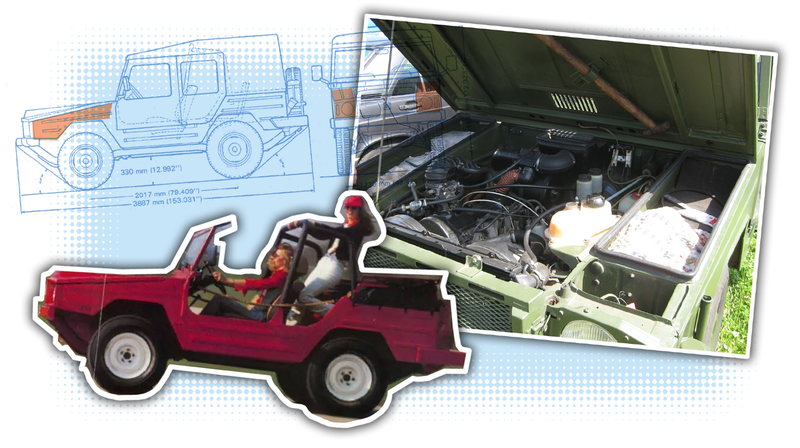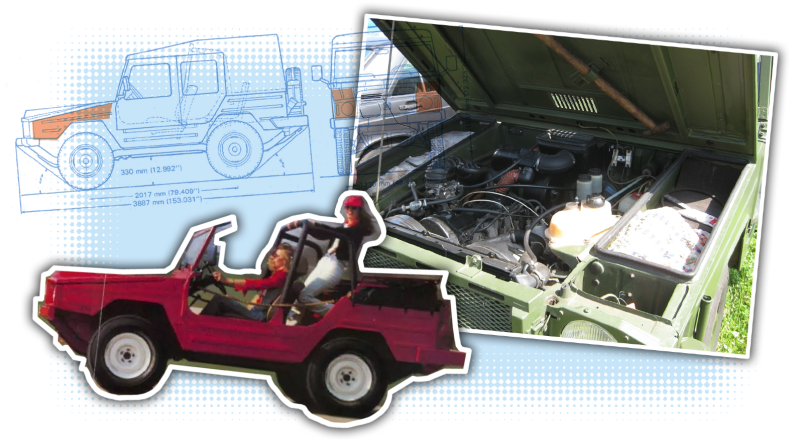
As you know, I’m a firm believer in the power of automobile trunks to teach us important lessons about life, and how best to live it. So far we’ve learned about creative thinking, determination, and the power of simplicity from various car trunks, and today there’s a potent lesson about taking opportunities we can learn from the trunk of a fairly rare but important car: the Volkswagen Iltis.
Really, I should say trunks, as in plural, not as in the goofy name for a bathing suit. That’s because the VW Iltis actually has three separate luggage compartments, though the lesson we’re going to be taught comes from just two of them.
The VW Iltis was an interesting car. It was designed to be a light military general-use vehicle, much like the very first car Volkswagen built in real quantities, the Kubelwagenand later the VW Type 181, which we knew as the Thing.
The Iltis wasn’t really a descendent of those cars, though; the Iltis was an evolution of the DKW Munga, which came into the VW fold when they were bought by Volkswagen as part of the Auto Union in 1964.
Advertisement
The Munga’s four-wheel drive system was further developed on the Iltis, and from there formed the basis of the famous Audi Quattro system. But look—we’re here to talk about inspirational trunks, not revolutionary four-wheel-drive systems, because I have damage in my brain, it seems.
The mechanical layout does factor into our discussion, though, because, as you can see above, the fundamental design used a longitudinal engine layout. On the Munga, the extra space to the sides of the engine was just dealt with via sloping bodywork, upon which sometimes you could strap a gas can, like in the image above. The Iltis took a different approach.
Advertisement
The Iltis used a full-width body, and while the hood did have a central bulge and some slight side sloping reminiscent of the Munga design, it was a much more modern look, and enclosed much more of the car’s volume.
The extra space on either side of the engine could have been ignored, like it was ignored in so many wide cars with longitudinal inline engines, getting the easy benefit of a roomy engine compartment that allowed for lots of access to service the car. I’ve seen some cars where you could practically stand between the engine and the wheel wells.
Advertisement
The Iltis wasn’t quite that roomy and wide, but it did have some dead space above the front wheel wells.
While they could have ignored this space and nobody would have even noticed, the designers of the Iltis weren’t content with just that. The Iltis designers saw the space as an opportunity, and converted those normally forgotten volumes into two very usable little storage compartments:
Advertisement
Look at that! Sure, the wheel wells make them sort of oddly ramp-shaped spaces, but it’s actually a decent amount of storage space, ideal for the tools and equipment that a military/outdoor vehicle might have. That sort of equipment would otherwise have to be rattling around in the larger rear load area, getting in the way, or requiring to be boxed or bagged up or whatever.
The two front cargo compartments on the Iltis weren’t the most revolutionary thing about the car, but they were a definite plus to the design, and proved to be very useful. The trunk-related lesson here is that sometimes, there’s opportunities available to you, opportunities that everyone else just ignores, because that’s how it’s always been done.
Advertisement
So the next time you’re doing something, keep an eye open for the dead spaces. Think like the VW Iltis, and see what forgotten volumes you can enclose in metal, add a rubber lip to, and make whatever you’re doing that much better, in a way that nobody ever suspected.
Trunks! Is there anything they can’t teach us?















